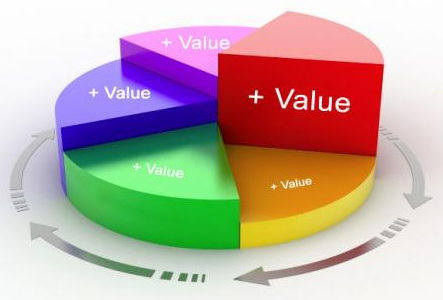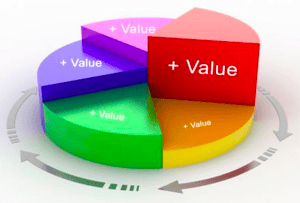Are your sales people suffering from value vagueness?
March 20, 2018

 Whether they are involved in winning new business or seeking to retain or expand existing business relationships, one of the key things that every member of your sales organisation needs to understand is how they establish unique value for each existing or prospective customer.
Whether they are involved in winning new business or seeking to retain or expand existing business relationships, one of the key things that every member of your sales organisation needs to understand is how they establish unique value for each existing or prospective customer.
In the case of new business, this is about the future value that your prospective customer believes they will derive from implementing your solution. In the case of existing business, it is about the actual business value they have already derived from using your solution.
This is nothing to do with having superior features or functions: it is about the superior business outcomes that your solutions enable your customers to achieve. You’d hope that understanding this would be baked into the DNA of any competent B2B sales person.
But all-too-often, when I ask sales people how they create tangible business value for their customers, their answers turn out to be disturbingly vague…
Projecting our potential value for new customers
The impact of this value vagueness on new business is profound. The most common reason why sales people lose apparently well qualified opportunities is because they failed to establish how their capabilities create clear and unique business value for their prospective customer. They either lose to a more value aware competitor or to a decision to do nothing.
If customers don’t see the need to act - if the discomfort of sticking with the status quo is less than the perceived cost and risk of change - the most common outcome is that after considering their options, they end up deciding they can live with their current situation.
Even if your sponsor sees the need for change, they will almost certainly have to persuade a group of senior stakeholders to sign the project off - and in most organisations of any significant size these ultimate decision makers require a robust business case before giving their agreement.
Recent research has shown that in 85% of cases your customers expect a significant business decision to be supported by a credible business case - but in a disturbing asymmetry, only 15% of vendor proposals include an adequate commercial justification. Is it any surprise that your sales people’s most common competitor is probably the status quo?
For new business customers, we need to get them to believe the future business value that will result from a decision to implement our solution. And that’s what it is - a projection, hopefully based on credible examples of past customer success. There’s inevitably going to be a certain level of imprecision or vagueness. Let’s not add to it!
Ensuring existing customers acknowledge the value we have created
But there’s absolutely no excuse for value vagueness when it comes to the benefits our existing customers have derived from their use of our solution. And yet far too few customer relationship managers - whether you label them installed base sales, account managers or customer success managers - seem to have anything like enough understanding of the business value that has been created for your customers.
Some don’t even bother to ask. Some don’t know how to ask. Some spend their lives talking to people on a day-to-day operational level who wouldn’t know how to answer the question. Some pride themselves on achieving “customer delight” but define or measure that largely in terms of an NPS score or the speed with which they respond to customer requests.
They may assume that their relationship is a good one. But they don’t understand what the strategic decision makers in their account value, or how they measure it. They are often painfully and dangerously unaware of the business outcomes that their solution is supporting.
So, when it comes to renewal time or if the customer’s business priorities shift, your presence in the account can suddenly become vulnerable. Someone - very likely NOT the people they have been interacting with on a day-to-day basis - asks “why do we need this solution?” or “couldn’t this be done cheaper?” and stimulates the vendor to engage in a panicky and often ineffective last-minute scramble to justify their value.
We can’t afford to wait to be asked. We need to understand what value our customer expected when they decided to invest in our solution, and we need to understand what measurable value we have actually enabled them to create.
We need to establish the proof points that support our value assertions. We need to make the power sponsors and change agents within the customer aware of our contribution. And we need to collaborate with them to identify other opportunities to drive further value. We can’t afford to be vague about our value, and we can’t afford for them to be vague about our value either.
This is a blindingly obvious challenge for most SaaS businesses, whose very business model depends on retaining and expanding their footprint in accounts. It’s why almost all of them now employ customer success managers. But even here, there is often room for improvement.
Whether by accident or design, many of these customer success functions are largely operationally focused, and only turn their attention to commercials when a renewal is due. It would be much more productive if every customer success function also saw its function as measuring the tangible business value that their solution was generating and making sure that this was visible to the strategic decision makers in the account.
The three vectors of value
So - what do your existing and prospective customers actually value? Inevitably, each individual customer will have different outcomes and metrics. But every customer environment has three potential high-level vectors of value:
Increase revenues
The first way in which you can create value for your customers is to enable them to increase their revenues. For example, your solution could help them to:
- Increase their prices
- Reduce their discounts
- Win more deals
- Increase their market share
- Increase their share of their customers’ wallets
- etc.
Reduce costs
You can also create value by enabling your customers to reduce their costs. For example, your solution could help them to:
- Spend less money
- Spend less time
- Improve efficiency
- Reduce or eliminate waste
- etc.
Achieve goals
The third - rather broader - category creates value by enabling your customer to achieve their corporate, departmental, functional or personal goals. For example, your solution could help them to:
- Eliminate risks
- Reach objectives
- Improve productivity
- Increase customer satisfaction
- Enhance their reputation
- etc.
Preferably you’ll want your customer to agree that you create tangible value across a number of different dimensions. But if they don’t believe you can create or have created any specific tangible value, your chances of winning a new customer or retaining an existing one are heavily compromised.
And remember, the only entity that can agree that something is valuable is your customer and the people that work for them. You can’t simply tell them. All you can do is to guide them, and to open their eyes. They have to recognise the value for themselves and confirm it back to you.
What next?
I strongly recommend that you initiate an urgent value audit for all significant current sales opportunities and existing customer relationships. Find out what is truly valuable to them. Establish how you contribute to it. Get them to agree the role they recognise that you are playing (or they expect you to play) in creating value.
Help them to acknowledge the unique attributes that allow you to create this value and make sure they establish a clear connection between the two. And then explore - with your now more value-aware prospect or customer - how you can collaborate with them to create the next wave of incremental business value.
And if any of these value audits draws a blank, or can only identify vague, amorphous and hard-to-pin-down value, I strongly suggest you get very focused on proving your value before your prospect or customer concludes that you have none.
IF YOU LIKED THIS, YOU'LL PROBABLY ALSO APPRECIATE:
BLOG: The many dimensions of diversity in B2B sales
BLOG: Sales training: should we emphasise technique or thinking?
BLOG: The issue with generic "unique value propositions"
BLOG: Discovery- the foundation of B2B sales success
BLOG: Are your sales people leading with gain or pain?
BLOG: Encouraging our sales people to think
BLOG: Are you selling "me-too" or "breakthrough"?
BLOG: Situational awareness - a critical factor in B2B sales
BLOG: Self-awareness and self-honesty in complex B2B sales
ABOUT THE AUTHOR
 Bob Apollo is a Fellow of the Association of Professional Sales and the founder of UK-based Inflexion-Point Strategy Partners, home of the Value Selling System®. Following a successful career spanning start-ups, scale-ups and corporates, Bob now works with a growing client base of tech-based B2B-focused high-growth businesses, enabling them to progressively create, capture and confirm their unique value in every customer interaction.
Bob Apollo is a Fellow of the Association of Professional Sales and the founder of UK-based Inflexion-Point Strategy Partners, home of the Value Selling System®. Following a successful career spanning start-ups, scale-ups and corporates, Bob now works with a growing client base of tech-based B2B-focused high-growth businesses, enabling them to progressively create, capture and confirm their unique value in every customer interaction.


Comments